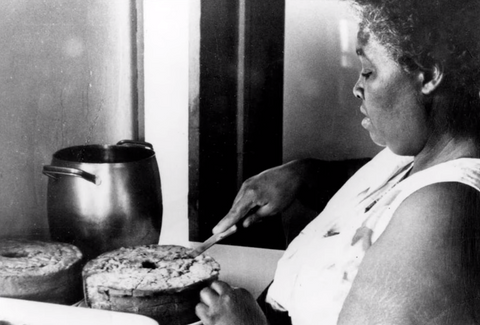
Georgia Gilmore deserves a statue.
In this month's newsletter, we're sharing stories of black women in food for Black History Month. And as a cookbook store owner, my personal Roman Empire is often wondering why women do not have more statues for the amazing work they do in this world. Further, if I were to suddenly find myself with the power to designate who gets a fancy bronze statue, one of my first projects would be to take down all the Lost Cause statues and replace them statues of a robust Georgia Gilmore at her kitchen stove making turnip greens, stuffed pork chops, and pound cake. As a society that values courage, boldness, and ingenuity everyone can certainly find something inspirational about a black woman living in the Jim Crow South using comfort food as her primary weapon against oppression.

Georgia Gilmore plating food to go at her stove.
At the heart of Gilmore's activism was her involvement with the Montgomery Improvement Association (MIA), the organization that coordinated the Montgomery Bus Boycott in response to the arrest of Rosa Parks in December 1955. Gilmore's role in the boycott was multifaceted and indispensable.
As a talented cook and entrepreneur, she raised critical early funding for the MIA by organizing a clandestine network of women to prepare and sell meals to those who supported the boycott. When folks asked her where she was able to collect the money she donated to the movement, she replied “Nowhere” and so named her organization “The Club From No Where.”
The widowed mother of six children was subsequently fired for her participation in the bus boycott and blacklisted from other employers in Montgomery. Pivoting quickly, she used her culinary talents to open a café in her home to feed Civil Rights workers, act as a community center for black and white customers, and provide private space for Civil Rights Leaders like Martin Luther King to meet and discuss strategies. Eventually, Dr. King would invite high level politicians like Lyndon B. Johnson and Robert Kennedy to her café to dine and discuss important issues. And Georgia Gilmore was right there in the center of it all.

Georgia Gilmore slicing pound cake at her stove.
Yet her activism extended beyond the kitchen. She was a fearless advocate for justice, speaking out against racial injustice and participating in demonstrations despite the risks to her safety. She also played a pivotal role in the legal battle against segregation alongside other boycott leaders. She was a plaintiff in the landmark case, Browder v. Gayle, which ultimately led to the United States Supreme Court ruling that segregation on buses was unconstitutional.
Despite facing harassment, intimidation, and economic hardship, Georgia Gilmore remained steadfast in her commitment to the cause of civil rights. Her courage and determination served as a beacon of hope for countless individuals, inspiring them to join the struggle for equality and justice. Now, we just need to figure out how to get those statues going.
Georgia Gilmore's Southern Pound Cake
Poundcakes have always been a prized selection at Southern bake sales and fundraisers due to the use of common pantry staples, buttery deliciousness, and excellent storage ability. Given the picture above of Ms. Gilmore slicing huge pound cakes above, I'm sure that her poundcakes served their own part in the Civil Rights Movement. This simple classic community cookbook recipe likely closely resembles the recipe she used. Every baker knows that poundcakes can take some practice to get the texture and crumb just right, but like the work of creating a more just world, it's absolutely worth the effort.
Ingredients:
1 pound butter
2 cups sugar
6 eggs
1 teaspoon vanilla
2 Tablespoons milk
1 cups flour
Assemble the cake:
1. Preheat oven to 350 degrees. Lightly grease a bundt pan.
2. Cream the butter and sugar together in a large bowl.
3. Add eggs, vanilla, and milk and mix.
4. Add the flour and blend together just until blended and no additional flour can be see. Do not overmix or pound cake will become tough.
Bake the cake:
6. Pour batter into the bundt pan and bake for approximately 1 hour or when a toothpick stuck into the center comes out clean.
7. After removing the pound cake from the oven, turn the pan upside down (some folks do this over a wine bottle).
8. Cut and serve after cake is fully cooled.
